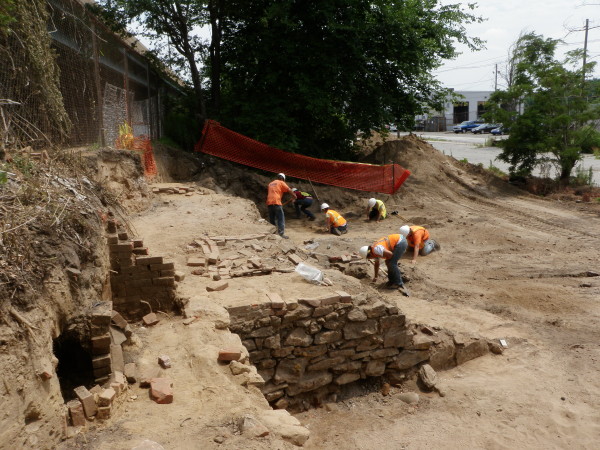Site Page
Port Richmond

Explore
Port Richmond:
| Site Name | Port Richmond |
| PASS# | 36PH0203 |
| Image | 1 image site overview |
| Dates of Excavation | 2010 |
| Phase of Excavation | Phase I, II and III |
| Number of Units | 0 |
| Approximate Number of Features Identified | 98 |
| Associated Periods | Early to late nineteenth century |
| Site Acreage | 3.01 |
Site History Summary
The land the Port Richmond Site occupied was originally part of William Ball’s eighteenth-century estate, and largely remained in his family until the 1840s, when developers acquired much of the block bounded by Richmond, Cambria, Melvale, and Ann Streets. Up to this point, little development had occurred on the block, which had only a few frame houses scattered across it and an old schoolhouse located at the corner of Cambria and Melvale. This situation began to change in the 1840s and picked up pace in the 1850s, as the village of Richmond transformed into the bustling Port Richmond with the construction of the Philadelphia and Reading Railroad’s terminal nearby.
As the population grew, buildings sprang up around the block and were quickly filled with residents and businesses catering to the rapidly expanding community. A majority of those living in Port Richmond were working-class Irish or German immigrants employed as laborers or in maritime trades. Others ran the boardinghouses, drug stores, clothing shops, bakeries, and saloons that lined Cambria and Richmond Streets.
What Did the Archaeological Excavation Reveal?
Excavations at the Port Richmond Site involved machine excavation of a portion of the block fronting along Richmond Street, revealing foundation remains of a church and a bakery. Excavation was also undertaken along the centerline of the proposed relocated Richmond Street to reveal historic features behind the structures that once stood on Richmond, Melvale, and East Cambria Streets. Remnants of property boundary walls and outbuildings were encountered, along with the remains of foundations along East Cambria Street. All of these foundations were substantially impacted during intense twentieth-century grading of the site. Fortunately, many of the privies and shaft features around these structures reached depths below this later disturbance.
Archaeological investigations in 2010 revealed a total of 10 brick shafts, 11 box privies, 8 barrel privies, and a large number of pit, post, and trench features. These features fell within the historic boundaries of 15 different properties on Richmond, Melvale, and East Cambria Streets. All of the features revealed during mechanical stripping were investigated archaeologically, producing over 60,000 artifacts dating from the mid-nineteenth century through the early twentieth century. The individuals and families represented in the recovered artifacts span a wide socioeconomic spectrum in the neighborhood.
Site Page
Port Richmond

| Site Name | Port Richmond |
| PASS# | 36PH0203 |
| Image | 1 image site overview |
| Dates of Excavation | 2010 |
| Phase of Excavation | Phase I, II and III |
| Number of Units | 0 |
| Approximate Number of Features Identified | 98 |
| Associated Periods | Early to late nineteenth century |
| Site Acreage | 3.01 |
Site History Summary
The land the Port Richmond Site occupied was originally part of William Ball’s eighteenth-century estate, and largely remained in his family until the 1840s, when developers acquired much of the block bounded by Richmond, Cambria, Melvale, and Ann Streets. Up to this point, little development had occurred on the block, which had only a few frame houses scattered across it and an old schoolhouse located at the corner of Cambria and Melvale. This situation began to change in the 1840s and picked up pace in the 1850s, as the village of Richmond transformed into the bustling Port Richmond with the construction of the Philadelphia and Reading Railroad’s terminal nearby.
As the population grew, buildings sprang up around the block and were quickly filled with residents and businesses catering to the rapidly expanding community. A majority of those living in Port Richmond were working-class Irish or German immigrants employed as laborers or in maritime trades. Others ran the boardinghouses, drug stores, clothing shops, bakeries, and saloons that lined Cambria and Richmond Streets.
What Did the Archaeological Excavation Reveal?
Excavations at the Port Richmond Site involved machine excavation of a portion of the block fronting along Richmond Street, revealing foundation remains of a church and a bakery. Excavation was also undertaken along the centerline of the proposed relocated Richmond Street to reveal historic features behind the structures that once stood on Richmond, Melvale, and East Cambria Streets. Remnants of property boundary walls and outbuildings were encountered, along with the remains of foundations along East Cambria Street. All of these foundations were substantially impacted during intense twentieth-century grading of the site. Fortunately, many of the privies and shaft features around these structures reached depths below this later disturbance.
Archaeological investigations in 2010 revealed a total of 10 brick shafts, 11 box privies, 8 barrel privies, and a large number of pit, post, and trench features. These features fell within the historic boundaries of 15 different properties on Richmond, Melvale, and East Cambria Streets. All of the features revealed during mechanical stripping were investigated archaeologically, producing over 60,000 artifacts dating from the mid-nineteenth century through the early twentieth century. The individuals and families represented in the recovered artifacts span a wide socioeconomic spectrum in the neighborhood.